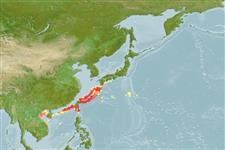>
Pleuronectiformes (Flatfishes) >
Cynoglossidae (Tonguefishes) > Symphurinae
Etymology: Symphurus: Greek, syn, symphysis = grown together + Greek, oura = tail (Ref. 45335); megasomus: Name derived from the Greek, 'mega' for large, and 'somus' for body, referring to the large size of this species and the deep body without obvious tapering in the posterior body..
Environment: milieu / climate zone / depth range / distribution range
Sinh thái học
Biển Sống nổi và đáy; Mức độ sâu 200 - 640 m (Ref. 82423). Subtropical
Sự phân bố
Các nước | Các khu vực của FAO | Các hệ sinh thái | Những lần xuất hiện | Point map | Những chỉ dẫn | Faunafri
Northwest Pacific: Taiwan.
Length at first maturity / Bộ gần gũi / Khối lượng (Trọng lượng) / Age
Maturity: Lm 12.3, range 10 - 14.342 cm
Max length : 14.7 cm SL con đực/không giới tính; (Ref. 82423); 14.3 cm SL (female)
Short description
Khóa để định loại | Hình thái học | Sinh trắc học
Các vây lưng mềm (tổng cộng) : 106 - 111; Tia mềm vây hậu môn: 91 - 96; Động vật có xương sống: 55 - 58. This species is distinguished from all its congeners, except S. hondoensis and S. undatus, by its predominant 1-2-3-2-2 ID pattern. It also differs from both abovementioned species in having smaller eye (5.3-7.9% HL vs. 11.0-14.9% HL in S. hondoensis and 11.5-13.8% HL in S. undatus). This species further differs from S. hondoensis
in having 9 abdominal vertebrae (vs. 10). S. megasomus is also distinguished from S. undatus, by having higher fin-ray counts, 106-111 dorsal-fin rays and 91-96 anal-fin rays (vs. 101-105 dorsal-fin rays and 87-91 anal-fin rays) and a uniform straw-colored to dark brown ocular-side coloration (vs. freckled ocular-side pigmentation) (Ref. 82423).
This deep-water tonguefish species is known only from the continental shelf and upper continental slope off northeastern and eastern Taiwan; from 471-640 m by research vessels. Polychaetes, small crustaceans and some unidentified detritus were found in the digestive systems of fishes examined. Little else is known regarding the biology of this species (Ref. 82423).
Life cycle and mating behavior
Maturities | Sự tái sinh sản | Spawnings | Egg(s) | Fecundities | Ấu trùng
Lee, M.-Y., H.-M. Chen and K.-T. Shao, 2009. A new species of deep-water tonguefish genus Symphurus (Pleuronectiformes: Cynoglossidae) from Taiwan. Copeia 2009(2):342-347. (Ref. 82423)
IUCN Red List Status (Ref. 130435)
Threat to humans
Harmless
Human uses
Các công cụ
Special reports
Download XML
Các nguồn internet
Estimates based on models
Preferred temperature (Ref.
123201): 9.6 - 16.7, mean 12.5 °C (based on 17 cells).
Phylogenetic diversity index (Ref.
82804): PD
50 = 0.5000 [Uniqueness, from 0.5 = low to 2.0 = high].
Bayesian length-weight: a=0.01445 (0.00647 - 0.03228), b=3.05 (2.85 - 3.25), in cm total length, based on LWR estimates for this (Sub)family-body shape (Ref.
93245).
Mức dinh dưỡng (Ref.
69278): 3.3 ±0.4 se; based on size and trophs of closest relatives
Thích nghi nhanh (Ref.
120179): Chiêù cao, thời gian nhân đôi của chủng quần tối thiểu là dưới 15 tháng (Preliminary K or Fecundity.).
Fishing Vulnerability (Ref.
59153): Low vulnerability (10 of 100).
